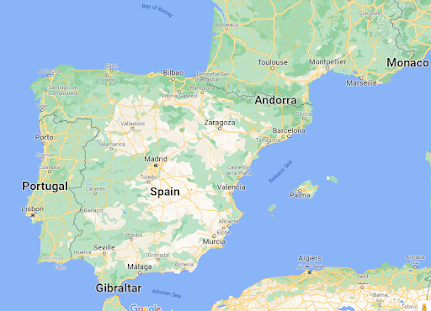The name Iberia is of Greek origin (Iβερια): the name the ancient Greeks used for the westernmost land they knew in the Mediterranean. Iberian Peninsula is principally divided between Spain and Portugal, comprising most of their territory, as well as a small area of Southern France, Andorra and Gibraltar.
The oldest known human DNA in Iberia comes from a 19,000-year-old skeleton found in 2010 in a cave called El Mirón, in northern Spain. People in Iberia continued to live as hunter-gatherers for thousands of years after that, long after the end of the Ice Age.
Manuel Gongora in 1861 suggested that the Iberian Peninsula had been inhabited as a result of a migratory wave of Iberian groups (who originated form the east) and subsequent invasion of Celts tribes across the Pyrenees (who succeeded in dominating the Iberian communities that they encountered). The merging of these two communities in the Iberian Peninsula, led to the formation of the Celtiberian ethnic group.
However, according to Lasalde in 1879, these were the Celts who first settled in the peninsula. They were followed by several other invasions by Galicians, Iberians and Bastetani, who pushed the existing populations further to the center of the Peninsula.
In the south, Iberian culture is influenced by civilizations of the eastern Mediterranean through trade and colonies established first by the Phoenicians, and later the Greeks, Carthaginians, and Romans.
The existence in Iberia of an agrarian society that was already well developed during the Roman domination and surely profoundly transformed large parts of the territory.
The silver trade brought Greek and Phoenician settlers to the peninsula, where, by the time of the Romans, they had already urbanized the coastline at, places like Cadiz, Toscanos, and Ampurias.
Much evidence suggests that Iberian religion encompassed many characteristics of Mediterranean religion. The symbols of suns moons and stars can be found in “solar and lunar cults in islands and on capes. Animal worship was also an important part of early Iberian religion. The Cult of the bull was found in Iberia in Balearic and Andalusian sanctuaries.
Phoenicians from the Near East built trading ports there 3,000 years ago, and Romans conquered the region around 200 B.C. Muslim armies sailed from North Africa and took control of Iberia in 711, they crossed the strait, which so far had been called the Pillars of Hercules but thereafter was called the strait of Gibraltar.
They seized the country and occupied the major part of the territory in the first centuries of their domination period. The Islamic civilization in Spain encompasses many fields that left a profound imprint in the Iberian Peninsula and Europe. The cultural climate of Spain in the era of Muslim rule (711-1492) brought about a prospering of different aspects of science and culture. Numerous schools and libraries were established and books were procured due to which the majority of the people were literate. Literature and art flourished.
After a few centuries, their domination area was progressively reduced until their presence in Iberia was ended. This happened almost eight centuries after they entered in the Peninsula; it ended when the last Muslim kingdom of Granada was conquered by Castile in 1492.
Iberian Peninsula civilization
An Introduction to Nuo Mi Xiang Pu-erh (Glutinous Rice Fragrant Tea)
-
Glutinous Rice Fragrant Tea, also known as *Nuo Mi Xiang Pu-erh*, is a
distinctive specialty within the world of Chinese teas. It combines the
smooth, ea...
